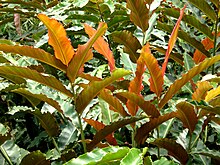| Etlingera fulgens | |
|---|---|

| |
| Scientific classification | |
| Kingdom: | Plantae |
| Clade: | Tracheophytes |
| Clade: | Angiosperms |
| Clade: | Monocots |
| Clade: | Commelinids |
| Order: | Zingiberales |
| Family: | Zingiberaceae |
| Genus: | Etlingera |
| Species: | E. fulgens |
| Binomial name | |
| Etlingera fulgens (Ridl.) C.K.Lim, 2000 | |
| Synonyms | |
|
Hornstedtia fulgens, Nicolaia fulgens, Phaeomeria fulgens | |
Etlingera fulgens is a species of herbaceous perennial plant of the family Zingiberaceae. This species occurs in southern Thailand and peninsular Malaysia. E. fulgens is used as an ornamental plant in landscape gardens for its bright red flowers and young leaves.
Description
Etlingera fulgens can be recognized by its shiny undulating leaves that are dark green in colour. When young, the undersides of its leaves are bright red in color, turning greenish on maturing. In older leaves, only the petiole and midrib are red. Petioles are 1.5–2.0 cm (0.6–0.8 in) in length. Rhizomes, 3 cm (1.2 in) in diameter, occur just below the ground. The plant can grow up to 5 m (16 ft) tall. Crushed leaf sheaths emit a pleasant sour fragrance similar to that of Etlingera elatior. Inflorescences are raised above the ground and infructescences are globular in shape.
Chemistry
Leaves of E. fulgens displayed stronger ferrous ion-chelating ability than young leaves of Camellia sinensis. Chlorogenic acid found in leaves of E. fulgens was higher in content than Lonicera japonica (Japanese honeysuckle), the commercial source. Fruit and rhizome oils of E. fulgens are mainly aliphatic hydrocarbons with cyclododecane, dodecanol, and cyclotetradecane as main constituents. Oils of E. fulgens and E. elatior were very different in composition despite having very similar aroma. Oils of E. fulgens consist mainly of dodecyl acetate (21.6%), an ester, and pentadecanol (14.1%) and hexadecanol (3.60%), both long-chain alcohols.
References
- ^ Lim, C.K. (2000). "Taxonomic notes on Etlingera Giseke (Zingiberaceae) in Peninsular Malaysia: the Nicolaia taxa". Folia Malaysiana 1: 1–12.
- ^ Khaw, S.H. (2001). "The genus Etlingera (Zingiberaceae) in Peninsular Malaysia including a new species". Gardens' Bulletin of Singapore. 53: 191–239.
- Chan, E.W.C., Lim, Y.Y., Omar, M. (2007). "Antioxidant and antibacterial activity of leaves of Etlingera species (Zingiberaceae) in Peninsular Malaysia". Food Chemistry 104 (4): 1586–1593. doi:10.1016/j.foodchem.2007.03.023.
- ^ "Chan, E.W.C. (2009). "Bioactivities and chemical constituents of leaves of some Etlingera species (Zingiberaceae) in Peninsular Malaysia". Ph.D. thesis, Monash University, 305 p." Archived from the original on 2012-12-03. Retrieved 2010-02-08.
- Chua, L.S.L., Nor Azah, M.A., Sam, Y.Y., Mailina, J. (2005). "Wild gingers of Peninsular Malaysia: Conservation studies and investigation into their essential oils". In: Nor Azman, H. et al. (Eds.) Proceedings of the Eighth Malaysia Plan IRPA Seminar 2004, Forest Research Institute Malaysia.
| Taxon identifiers | |
|---|---|
| Etlingera fulgens | |
| Hornstedtia fulgens | |